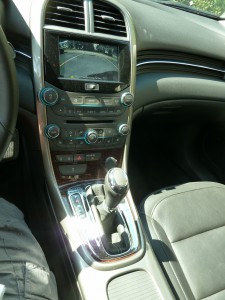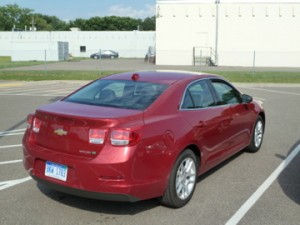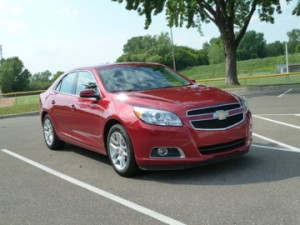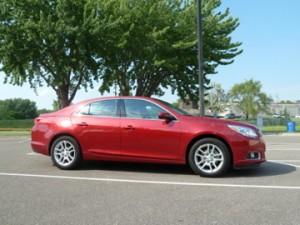Malibu hustles to join midsize maze
By John Gilbert
In the face of onrushing new midsize cars from competitors, Chevrolet answered with a pre-emptive move — hustling out the 2013 Malibu so far ahead of plans that the car virtually beat its own engine to the showrooms.
The Malibu rekindled fond memories when it returned after a decade of extinction in the mid-1990s, and it might rekindle memories of Chevrolet’s once-lofty status for producing state-of-the-art midsize sedans if the totally redone 2013 model lives up to its initial ratings.
Chevrolet undoubtedly knew midsize competition was fierce and getting fiercer, as the Toyota Camry segment king has already been revised, and the Hyundai Sonata and Kia Optima Korean breakthrough siblings challenged for prominence. A new Nissan Altima generation has just been introduced too, soon will be joined by the renewed Honda Accord and the much-publicized new Ford Fusion.
If a drastic measure was called for, the new Malibu is taking a healthy swing at the challenge a year ahead of original schedule. It will be offered only as a 4-cylinder Eco, with GM’s “eAssist” mild hybrid scheme, while General Motors finishes building its all-new 2.5-liter 4-cylinder, which should be available later in 2012. Even then, the pair of 4-cylinders will be the only choices, as Chevy joins the trend of dropping V6es in favor of higher-output 4s with far better fuel economy.
Styling has been a feature of Malibus since the 1960s, when it was born as a fancy upscale model of the Chevelle. When Malibu was brought back in 1997, it was nice enough, but seemed to slip a little when some competitors in the congested midsize class took some bold styling steps. The new Malibu makes up for some of that.
It has the new-signature corporate grille, with a large trapezoidal opening, split by a horizontal bar above the midpoint. That identifying trademark first appeared on the previous Silverado pickup redo, and has since proliferated to distinguish the Volt, Cruze, subcompact Sonic and mini-car Spark, along with the Malibu.
That’s one of the issues with a so-called “signature” look: At a glance, you’re uncertain what’s coming at you, and Malibu buyers might be less than thrilled that their front end has a Cruze-Sonic look. It is, however, an asset from the rear, where the sculpturing of the rear bumper and tail, with four square taillights, and a spoiler lip designed into the trunklid, make a strong resemblance to the stylish and muscular Camaro.
Overall, the look retains the appearance of the outgoing Malibu, until you scrutinize all the elements, even though the car now switches to a shorter-wheelbase platform. The hood has some nicely contoured lines that sweep back to the “A” pillar framing the windshield and front doors, and the silhouette has a pleasant, contemporary look.
Inside, the front has improved bucket seats that are more supportive, and a classy touch is the soft-touch dash and door facings, a pebble-like “football-grain” texture. There is only a thin strip of fake woodgrain on teh dash, a touch I applaud because I always thought “less is more” was the appropriate response to phony woodgrain.
The only thing not new about the new Malibu as it sells through the Summer of 2012 is the 4-cylinder engine, which is the familiar 2.4-liter implement used in the Buick fleet of LaCrosse, Regal and even Verano. In the Malibu, the 2.4 is accompanied by a lithium-ion battery pack, which, just like the LaCrosse and Regal, turns into an “eAssist” mild hybrid. The electric power will not run the car by itself, hence the “mild” terminology, although it does handle electricity needs and boosts the engine’s output to 180 horsepower.
That’s adequate to pull the new Malibu around, in sort of a high-tech, front-wheel-drive manner. When the new 2.5-liter 4-cylinder joins up, it will become the “standard” engine in the Malibu, while the current mild-hybrid 2.4 becomes the option.
Looking ahead, the new 2.5 will be a dual-overhead-camshaft, direct-injected engine that should do justice to the tag-line “EcoTec” that has been attached to every small engine Chevy has installed over the last decade. The new engine will be a test of GM’s ability to make its own world-class 4-cylinder to take on some very impressive high-tech engines from competitors. In recent years, Chevy and GM have found their best small 4s can be brought in from Opel, its German branch.
The new engine will reportedly have “at least” 190 horsepower and 180 foot-pounds of torque, and 30-plus miles per gallon, according to early evaluations. That will be important, because when Hyundai first put its high-pressure gas-direct-injection system on its new 2.4-liter 4 for the 2011 Sonata, it came in at 198 horsepower, and has gotten high-30s and even into the 40-mpg realm.
Chevy is also following others’ lead and gambling that no V6 will be demanded in the new Malibu. Global concentration on reducing emissions and improving fuel-efficiency led Hyundai to make that move, and the 2011 Sonata and Optima may have caught the industry by surprise, using only 4 cylinders. But the Buick Regal followed suit, and Ford announced its new Fusion would have only 4-cylinder power, while Nissan’s new Altima, and reportedly Honda’s upcoming Accord are also devoted to 4-only power.
Comparisons to the Buick Regal are logical, because the Regal — which has changed Buick’s reputation from aging buyers to a sportier and younger audience — is based on the Opel Insignia and helped direct the Malibu’s direction.
To quickly trace that heritage, General Motors attempted to rejuvenate Saturn by rebadging an existing Opel Vectra as the Saturn Aura. It worked, as the Aura won North American Car of the Year. A year later, GM rebadged it again as the new Malibu, and it, too, won Car of the Year. In time, Saturn’s nameplate disappeared, as did Oldsmobile’s, while Buick remained, ostensibly because it had established a foothold in the new market of China. Meanwhile, it was time to redo the Opel Vectra in Germany, so GM decided to call the new model the Opel Insignia, and a version of that car went to Buick as the Regal.
The new Malibu moves onto the same Epsilon II platform as the Insignia and Regal, which makes its wheelbase 4.5 inches shorter than the 2012 Malibu. Interior room is actually increased, though, by widening the car by 2.7 inches. The new Malibu’s dimensions are 191.3 inches in length, 107.8 inches in wheelbase, 73 inches wide, with a height of 57.6 inches.
Despite using 60 percent high-strength steel, and liberal amounts of aluminum, the Malibu still weighs in at about 3,500 pounds. Much of that can be attributed to considerable attention to adding sound-deadening materials.
In a week’s living with the new Malibu Eco, acceleration from a stop was unimpressive, but adequate, as the weight of the car seemed to outweigh, so to speak, the 15 extra horsepower electric boost that raises the 2.4 to 180 horsepower and 170 foot-pounds of torque. Once underway, the Malibu performed adequately, and it held freeway speeds without any difficulty, as expected, while delivering good fuel economy.
The battery pack is housed under the trunk’s front floor, and it does limit trunk space. My son, Jack, said he couldn’t fit his golf bag into that trunk, which may indicate he has too many clubs, but it also means luggage space is adequate but not spacious.
The EPA estimates for the Malibu Eco are 25 city and 37 highway, and on my standard test it got a high of 35.7 on sustained freeway driving. Topping the 30-mark is of utmost importance, even though many competitors have routinely reached 30 over the last decade.
Handling performance is good, with tightly precise steering and firm but never harsh suspension. Rear seat room is good, and if the shorter wheelbase drops it down from the largest midsize competitors it’s still adequate, and leaves room for the larger Impala, whenever Chevy chooses to modernize its large sedan.
Amid all the ambient lighting and connectivity, there is also a 7-inch screen for navigation and audio and other vehicle readouts. A leather seat package with both front buckets heated, drove the base price up from $26,845 to a sticker of $29,230 on the test car.

Poorly placed bright-silver gear lever surround captures sunlight and reflects it into driver's eyes.
While most of the interior amenities are impressive, one that misses a beat is the area surrounding the console shift lever. There is a strip an inch or two wide surrounding the shift lever, and some stylist decided it would be artsy to make it a convex strip of super-bright chrome silver. The problem is that any time you’re driving into the sun, the reflection off that bright silver is an annoyance and possibly a distraction. The fact that it has a stylish concave design means that it will pick up any sunlight and part of it will ricochet off the curved silver and shoot directly into the driver’s eyes. Simply making that surround out of brushed satin silver, or any dark material — even the hated fake woodgrain — would alleviate the problem. Makes you wonder if anyone test-drove the finished Malibu on a sunny day.
On the other hand, the large navigation screen is a nice surprise, because until now, the popular nav system wasn’t available on any Malibu, leaving only On-Star for finding your way. On-Star is always impressive to use by voice commands, but it was no excuse for avoiding the popular swing toward visual map-following on a dashboard screen. Another problem solved.
Comments
Tell me what you're thinking...
and oh, if you want a pic to show with your comment, go get a gravatar!





 John Gilbert is a lifetime Minnesotan and career journalist, specializing in cars and sports during and since spending 30 years at the Minneapolis Tribune, now the Star Tribune. More recently, he has continued translating the high-tech world of autos and sharing his passionate insights as a freelance writer/photographer/broadcaster. A member of the prestigious North American Car and Truck of the Year jury since 1993. John can be heard Monday-Friday from 9-11am on 610 KDAL(www.kdal610.com) on the "John Gilbert Show," and writes a column in the Duluth Reader.
John Gilbert is a lifetime Minnesotan and career journalist, specializing in cars and sports during and since spending 30 years at the Minneapolis Tribune, now the Star Tribune. More recently, he has continued translating the high-tech world of autos and sharing his passionate insights as a freelance writer/photographer/broadcaster. A member of the prestigious North American Car and Truck of the Year jury since 1993. John can be heard Monday-Friday from 9-11am on 610 KDAL(www.kdal610.com) on the "John Gilbert Show," and writes a column in the Duluth Reader.